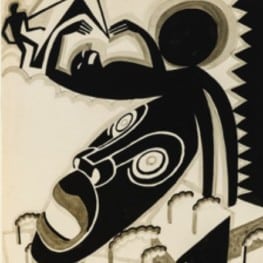Winold Reiss
1886-1953
Winold Reiss’ boundless talent and inspired imagination produced some of the 20th century’s most indelible portraits. Born in Karlsruhe, Germany in 1886, Reiss achieved artistic fluency in the fine and decorative arts during his studies at the venerable Kunstgewerbeschule (College of Arts and Crafts) in Munich. The school’s unorthodox curriculum of graphic arts, interior design, and landscape and portrait painting laid the aesthetic seeds for the development of the artist’s unique style as a graphic and interior designer, and ultimately his maturation as a pioneer of American modernism.
In 1913, concerned about the foreboding political climate in his homeland, Reiss set sail for America. His decision to emigrate was a journey he was eager to take. Growing up he had been a voracious reader of the German writer Karl May’s popular novels of the American West. Reiss’ ocean crossing was fueled by his determination to pursue his romance with the “Wild West.” Confronted with the mundane realities of earning a living in New York City, Reiss was forced to put his travel plans on hold. In the intervening years, his multidisciplinary training provided the lifeline he needed to survive as an artist. Reiss immediately found work as an illustrator, interior designer and teacher.
In 1920 Reiss took what would be the first of many trips out west, to Montana, where he completed thirty-six portraits of Blackfeet Indians. The portraits were acclaimed for their humanity as well as Reiss’ bold and decorative use of color. The works were exhibited in the artist’s first solo show in New York and met with immediate success—all the pictures were purchased by one collector.
During this period, Reiss continued to produce portraits, including a series based on his travels to Mexico and an historic collection of pastels of African Americans that today reside in the National Portrait Gallery in Washington. However, it was Reiss’ interior design commissions during the building boom of the 1920s that brought him income and recognition. But with the onset of the depression these opportunities seemed to evaporate overnight.
In the early 1930s, Henry Lustig’s commission for two new Longchamps restaurants in New York City helped revive Reiss’ career. The artist would go on to do all the interior design for the Longchamps restaurants until shortly before he died in the 1953.


